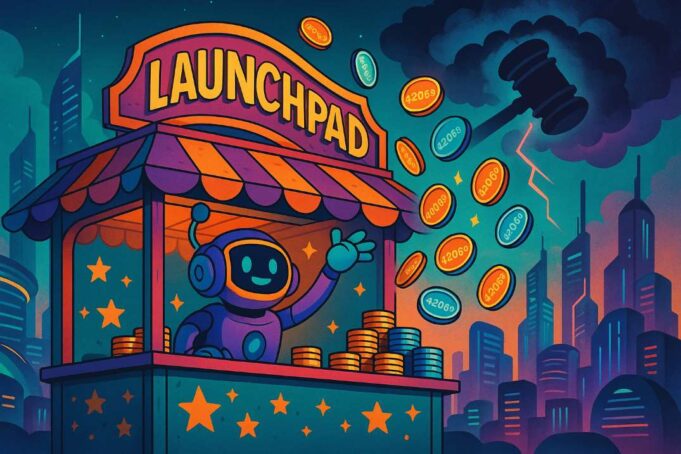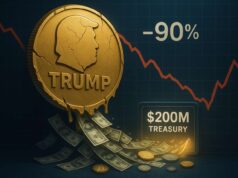Pump.fun, the viral Solana-based launchpad that turned chaotic meme culture into on-chain financial engineering, is preparing for its boldest move yet: a $1 billion token raise that would give the platform a projected $4 billion valuation. Known for its frictionless, permissionless token creation model and absurdist branding, Pump.fun now seeks to evolve into a fully tokenized platform with the release of its native PUMP token. This shift comes as legal scrutiny intensifies, with the platform facing multiple class-action lawsuits over alleged securities fraud.
What Is Pump.fun and How Did It Work Until Now?
Pump.fun emerged as a decentralized crypto token launch platform built on Solana. It allows anyone to launch a meme coin in minutes, with no coding skills or approvals required. The platform automates liquidity provisioning and pricing using a bonding curve model. Early buyers get cheaper entry points, and token prices rise as demand increases.
Until now, Pump.fun operated without a native token. It generated revenue through protocol fees but lacked a governance or reward mechanism. Despite that, the platform exploded in popularity, launching over 11 million tokens and becoming a go-to for Solana meme token creators.
By simplifying token creation and capitalizing on viral momentum, Pump.fun built a decentralized meme coin ecosystem without issuing a token of its own.
Inside the $1 Billion Token Launch
The upcoming PUMP token launch marks a strategic transition. Pump.fun will issue 420.69 million PUMP tokens and aims to raise $1 billion through this initial coin offering (ICO). This $1B ICO crypto campaign will value the project at $4 billion.
The tokens will be distributed across community airdrops, influencer campaigns, and team allocations. A treasury will manage the remaining supply, likely through a multi-signature wallet. Reportedly, leading Web3 venture capital firm Standard Crypto is backing the platform. While the exact utility of the PUMP token is still unfolding, we should expect it to play a central role in governance, rewards, and access to future features.
Why Now? From Viral App to Token Economy
Pump.fun’s timing is deliberate. The platform has ridden the wave of Solana’s meme coin boom, alongside tokens like $WIF, $BODEN, and $BONK. The platform built its user base and brand well ahead and positioned itself to capture more value through tokenization.
By introducing its own token, Pump.fun is transforming from a utility-first DApp into a token-powered Web3 launchpad project. The tokenized meme economy it helped ignite is now becoming its primary business model. Through PUMP, the platform can reward loyal users, attract fresh liquidity, and reinforce its place in the Solana ecosystem.
Legal Headwinds and Securities Fraud Allegations
Despite its success, Pump.fun is under mounting legal pressure. Two class-action lawsuits are pending in the Southern District of New York. Plaintiffs argue that Pump.fun enabled the sale of unregistered securities through tokens like PNUT, FWOG, and GRIFFAIN. The lawsuits claim the platform is effectively a joint issuer of these assets.
Operated by Baton Corporation Ltd., Pump.fun is also accused of facilitating pump-and-dump schemes and failing to implement basic investor protections. The legal challenge worsened after law firms involved in the cases discovered tokens mocking their clients and attorneys on the platform, raising allegations of intimidation and bad-faith behavior.
If U.S. courts classify tokens launched via Pump.fun as securities, the entire decentralized meme token model may face regulatory upheaval.
Pump.fun’s Gamble: Parody, Profits, and Precedent
Pump.fun has always existed at the intersection of parody and profit. Its brand is a meme, but its numbers are real: hundreds of millions in fees, a billion-dollar raise, and a growing investor base. As it introduces a native token, the platform must now answer whether meme-fueled crypto projects can scale responsibly.
>>> Read more: Meme coins Are Just “Collectibles,” Says SEC
The PUMP token represents more than just capitalization, it marks a formal entry into a regulated digital economy. That transition may draw further attention from regulators already skeptical of decentralized finance.
Pump.fun’s gamble is clear: formalize its meme-powered empire without losing the viral magic that made it famous. Whether that strategy leads to sustainable growth or legal precedent remains to be seen.
Readers’ frequently asked questions
Does Pump.fun currently require KYC or investor verification for token creators?
No. As of June 2025, Pump.fun does not implement Know Your Customer (KYC) checks or age verification for users launching tokens. The class-action lawsuits raised this lack of investor screening as one of the issues.
What legal risks could buyers of PUMP tokens face?
If courts determine that tokens launched on Pump.fun (including PUMP itself) are securities, it could expose U.S.-based participants to compliance risks. The legal outcome may also impact future trading or the availability of the token on regulated platforms.
Is the $1B raise already completed or still upcoming?
The raise is still upcoming. The PUMP token launch and its $1B target have been announced but not finalized. The project has confirmed investor interest, including support from Standard Crypto.
What Is In It For You? Action items you might want to consider
Monitor the launch structure of PUMP tokens
Pay attention to how the PUMP token is distributed, whether through public sale, airdrop, or private allocations, and what governance or utility functions are promised.
Evaluate risk exposure before participating
If you’re based in a jurisdiction with active securities regulation (like the U.S.), consider the legal risks tied to meme coin projects and unregistered token sales before participating in PUMP-related offerings.
Track the legal proceedings closely
Follow updates in the two class-action lawsuits filed against Pump.fun. These cases could reshape the legal definition of meme tokens and influence the future of Solana-based launchpads.










